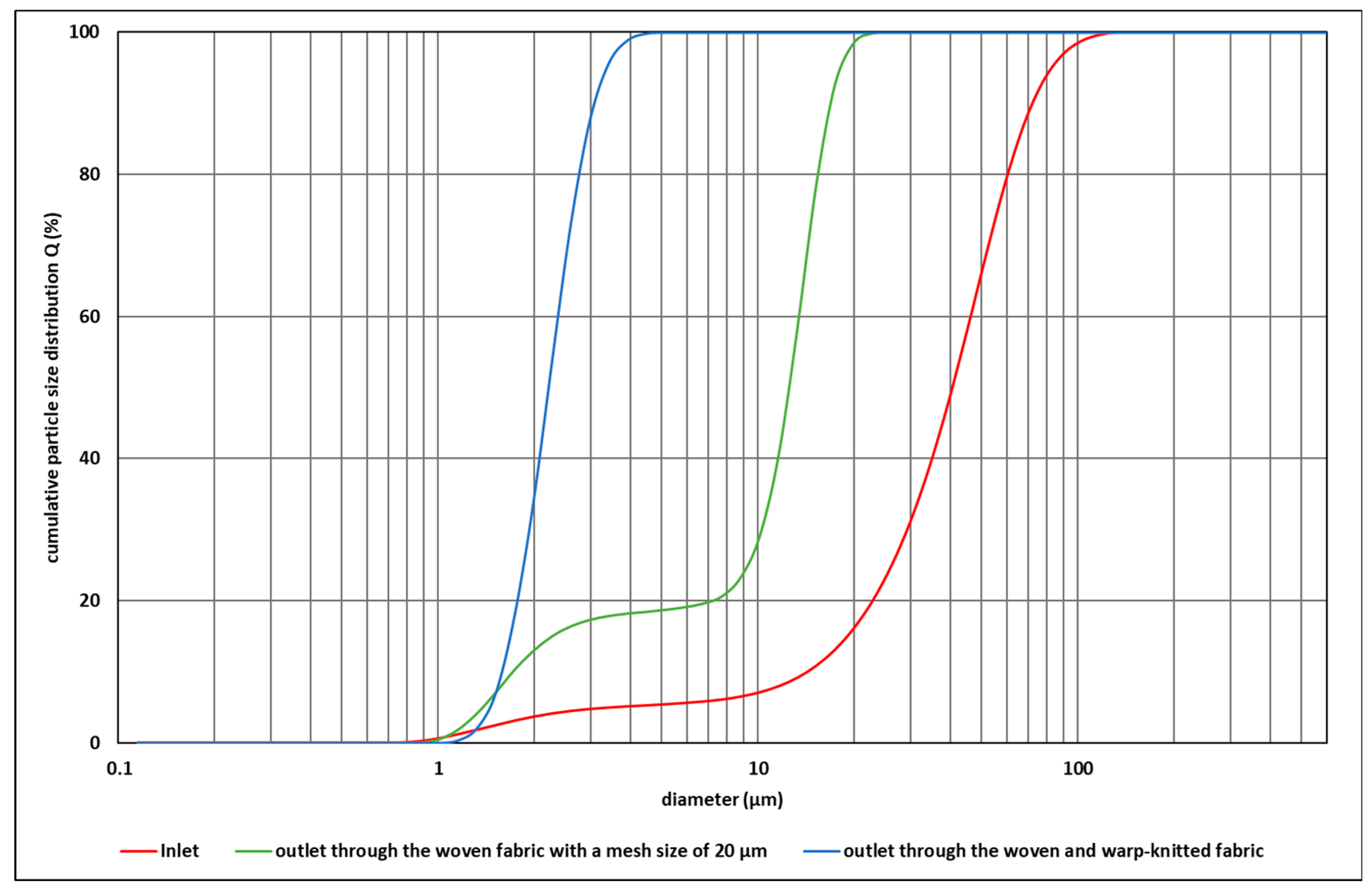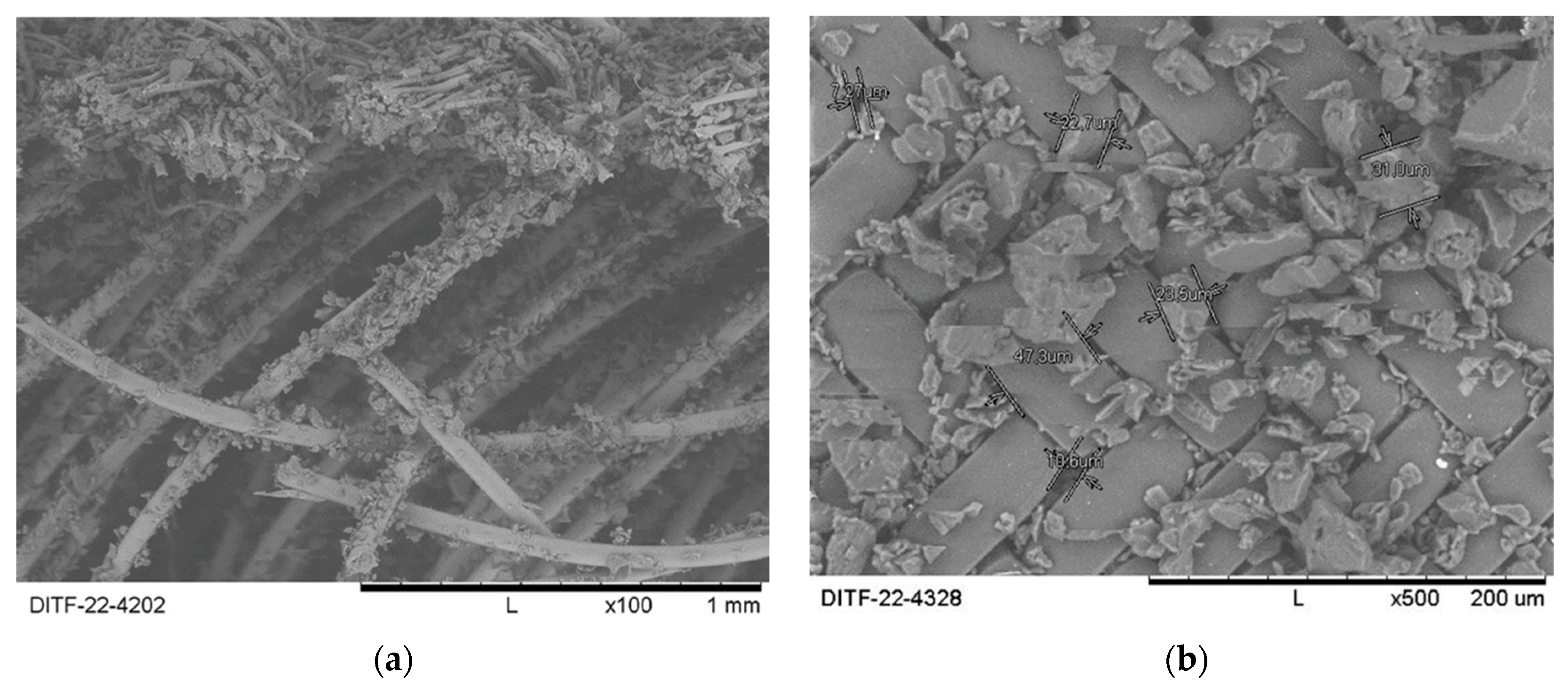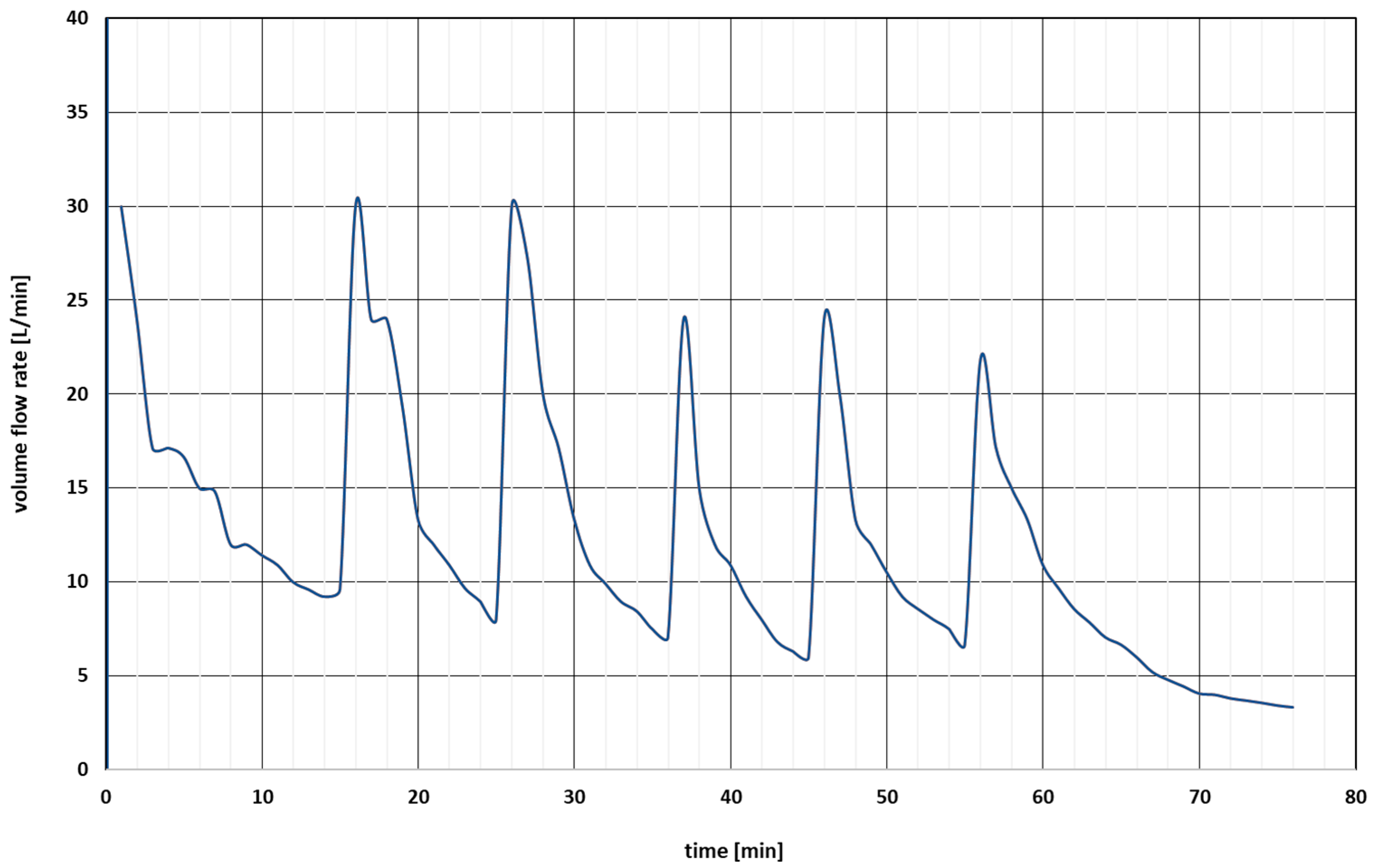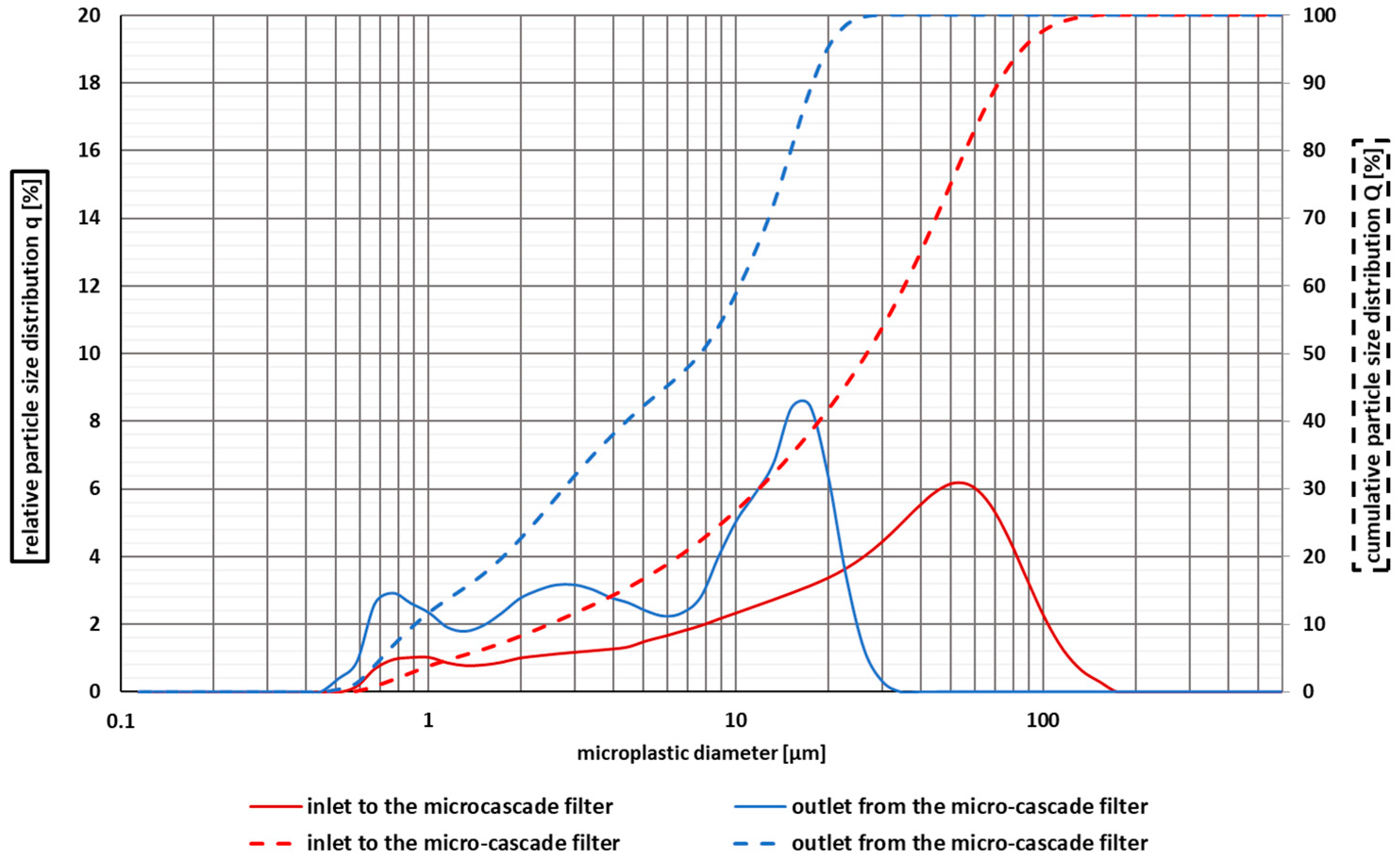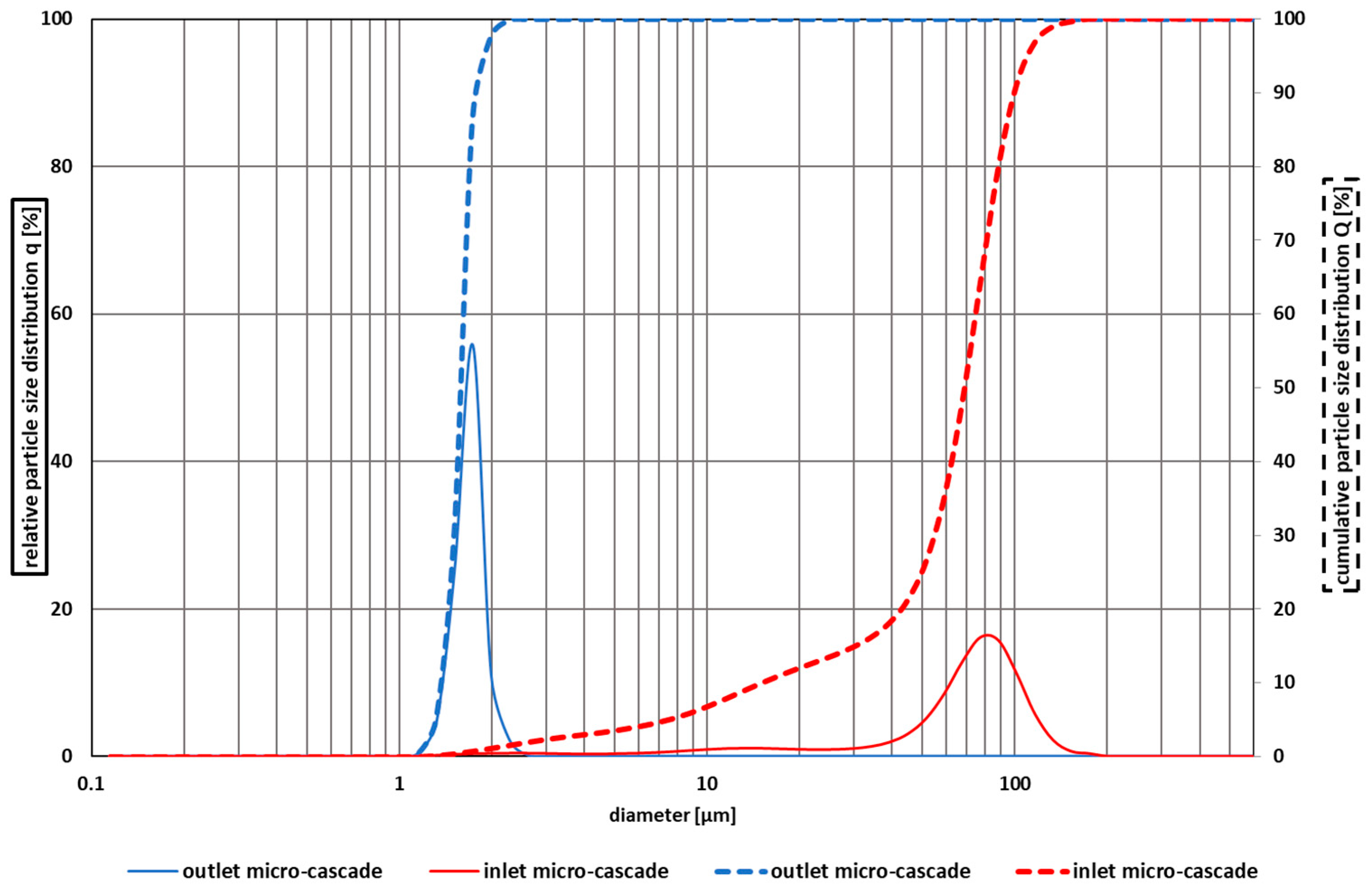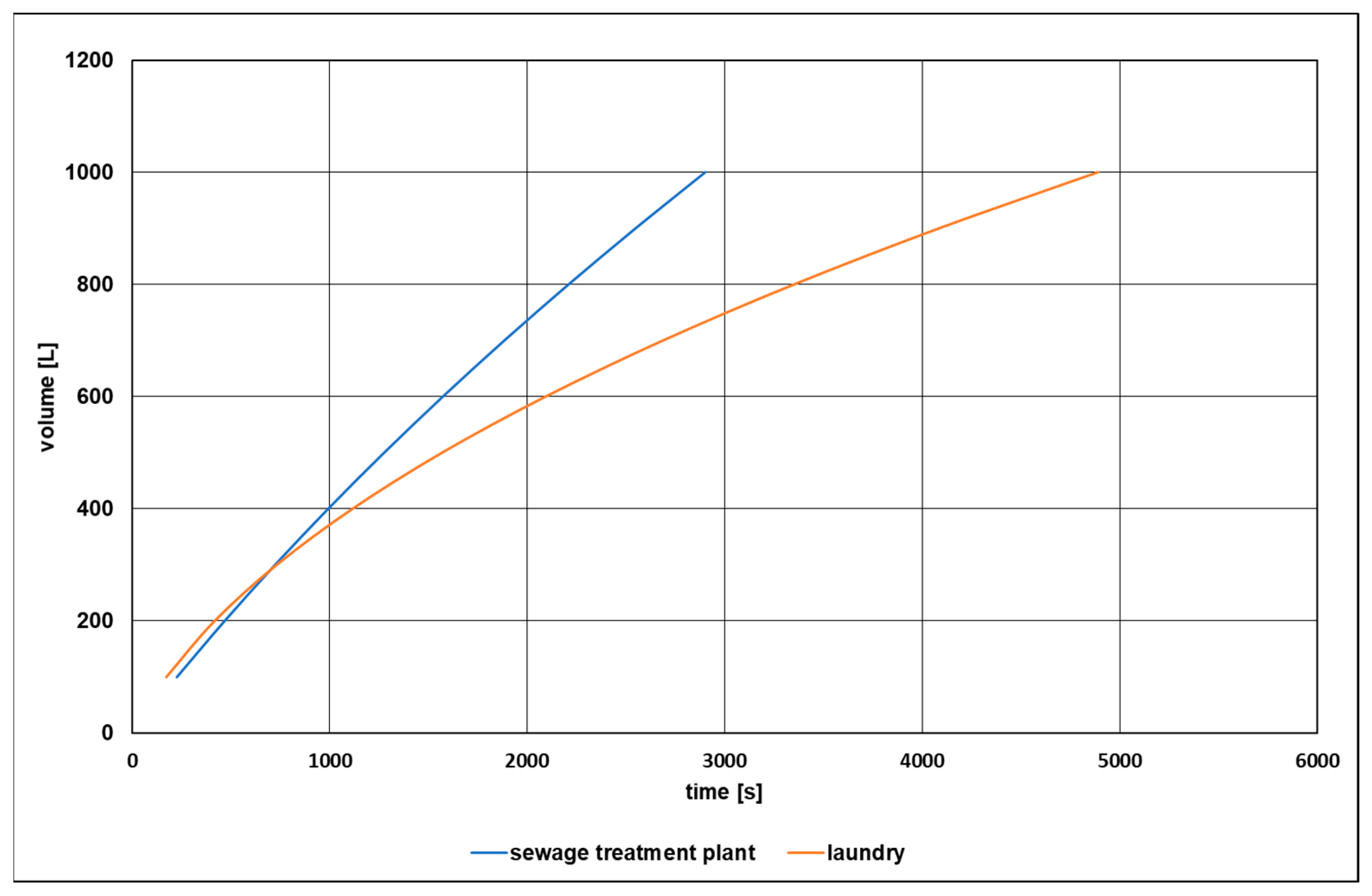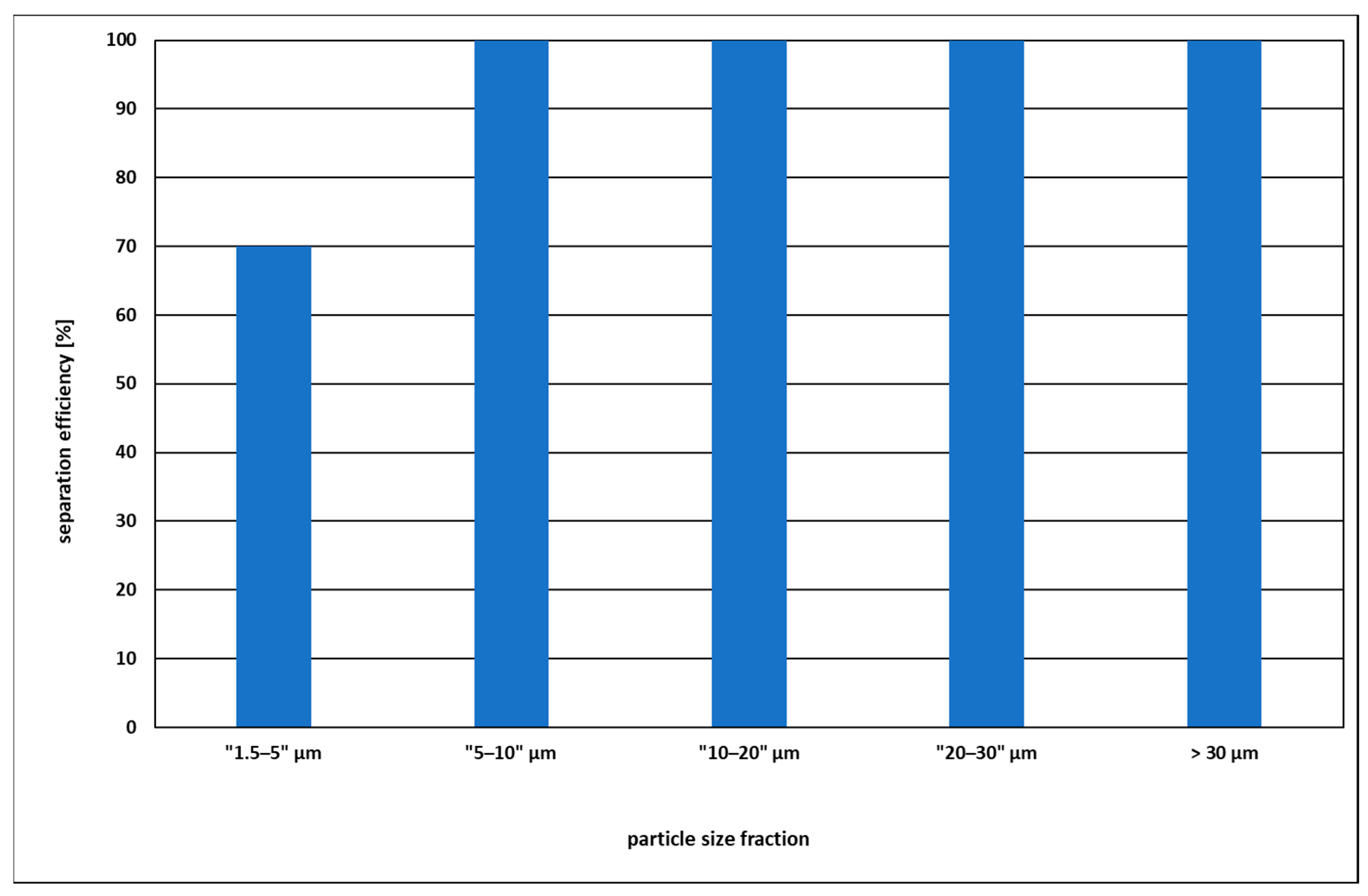1. Introduction
Microplastic pollution of the environment is currently gaining in relevance and is increasingly becoming the focus of social attention. Microplastics have been detected in all environmental areas and on all continents and waters [
1]. The ingestion of microplastics by marine organisms is a possible route for the spread of microplastics [
2]. After ingestion, microplastics can remain in the digestive system of living organisms for a certain period of time before being excreted. In this way, microplastics spread around the world and in the food chain [
2]. Observations have already been made that show detrimental effects on biological habitats [
3]. Häseler, J., Böckler, F. and Dill, B. et al. define microplastics as particles that are smaller than 5 mm [
4]. This definition also includes synthetic textile fibres with a length of less than 5 mm.
In their report on microplastics from textiles, Manshoven et al. conclude that the global release of microplastics from textiles amounts to 200,000 to 500,000 tons per year [
5]. Many studies have focused on the release of microfibres during the washing of synthetic textiles, as this is considered an important pathway into aquatic environments [
5]. The amount of microfibres released varies greatly and is estimated to be between and 12 to 1400 milligrams of microplastics per kilogram of textiles per wash cycle. This can correspond to 100,000 to 6 million microfibres per kilograms of textiles [
5].
Wastewater treatment plants can already remove a large portion of microplastic particles from wastewater, with a reduction of microplastic content up to 99% [
6,
7]. Despite this high removal rate, wastewater treatment plants can still be a significant source of microplastics in aquatic environments due to the large volumes of wastewater they discharge on a daily basis [
6].
Wastewater treatment technologies such as membrane bioreactors (MBRs) [
6,
8,
9], sand filters (RSFs) [
6,
10], flotation [
6], disc filters (DFs) [
6,
11], microfiltration [
12,
13,
14], ultrafiltration (UF) [
15,
16], nanofiltration (NF) [
8] and reverse osmosis (RO) [
8] are applied to remove microplastics from water. In addition to these established technologies, there are approaches based on chemical oxidation (AOPs) [
9], coagulation/flocculation [
12], electrocoagulation [
17], adsorption [
9] and magnetic separation [
9]. Microplastic filtration using filter cascades is mainly used for analyses [
18,
19].
The aim of this work is to develop and demonstrate a procedure for removing microplastics from washing rinse water from an industrial laundry company using a special filter cascade in a low-water-pressure process. For this purpose, a cascade filter based on a textile 3D sandwich filter media composite was developed that can capture microplastic particles from a size of 1.5 μm without a high-pressure drop occurring.
2. Materials and Methods
2.1. Microfilter Cascade
The microfilter cascade consists of three cascade stages connected in series. Each stage is equipped with a textile 3D composite sandwich material as a filter medium made of 3D warp-knitted fabric and woven fabric. This structure of the filter allowed for an easy cleaning and recovery of the filtration efficiently by applying a backwash step. Each stage filtered successively finer microplastic particles and thus reduced the load on the individual filter stages. The filter housings were developed by the company Polo Filter-Technik Bremen GmbH, 28832 Achim, Germany, with the model designation 087571 as part of ZIM cooperation project Micro cascade (KK5014729IE1) of AiF Project GmbH, 13156 Berlin. The housing filter contains holders for fabric and warp-knitted fabric as well as connections and valves for inlet, outlet, backwash and compressed air. The filter area was 0.005 m2.
A feed pump, type Calpeda MXH 202E 230V (Calpeda S.p.A., Montorso Vicentino, Italy), pushed the water through the filters. An additional 5 mm sieve was installed at the inlet of the feed pump. Backwashing was carried out with already filtered water against the normal filtration flow direction combined with compressed air blasts perpendicular to the flow direction, with gravity fulfilling a supporting function. The filter cake was discharged downwards.
2.2. Textile Filter Materials
Woven filter fabrics with different pore sizes were investigated for the cascade filter. In the screening tests, filter-woven fabrics made of polypropylene monofilaments with mesh pore sizes of 100, 50 and 20 µm proved to be suitable and were used in the filtration tests. Polypropylene was chosen for its high chemical resistance, mechanical durability and long-standing industrial application in filtration technologies.
Three-dimensional warp-knitted fabrics were developed for cascade filtration that consist of 80% texturized multifilament yarns. The pile yarn layer contains 20% monofilaments to stabilize the 3D geometry. The basis weight of the fabrics was 800 g/m
2, and the thickness was 17 mm. The specific surface area of the fibres is in sum 1000 m
2/m
3 in total, and the porosity of the warp knitting was 96%.
Figure 1 shows a close view of the 3D warp-knitted fabric made of polypropylene.
The filter medium used in this study consists of endless filaments, mechanically entangled and manufactured under controlled industrial conditions. The tensile strength of these filaments is at least 240 N per filament. This structure is designed to significantly reduce mechanical abrasion and in this way the generation of microplastics coming from the filter media itself.
2.3. Particle Composition and Properties
The suspension used for the filtration tests consisted of process water and model polyethylene (PE) microplastic particles. The use of such particles made it possible to repeat the tests at any time under the same repeatable conditions. Particles with a median of 46.51 μm were used for the tests. The concentration of the suspension in all tests in the pilot plant was 167 mg of microplastics per litre of process water. Analyses in a laundry facility revealed a microplastic concentration of 167 mg/L in the wastewater. Therefore, this study was conducted using this concentration of model particles.
2.4. Sampling and Analytical Measurements
A Microtrac Sync hybrid particle analyser was used to quantify the collective of microplastic particles. It is equipped with
- ○
Dynamic image analysis with laser diffraction 3R (3 red lasers, 780 nm wavelength) and a measuring range laser: wet 0.02–2000 μm;
- ○
Dynamic image analysis L-Range, detection limit 1.6 μm and a measuring range camera: wet 1.6–2000 μm;
- ○
Wet dispersion module FlowSync standard (200 mL) FlowSync module;
- ○
A wet dispersion module and an internal ultrasound probe.
The distribution of microplastic particles on the filter composite material was examined using a tabletop scanning electron microscope (SEM), model Hitachi TM 1000 (Hitachi, Tokyo, Japan), along with the associated TM 1000 software, Dimension LS, version 2.1.0.
The pressure drop Δp required for micro-cascade filtration is generated by overpressure on the inlet side by a pump. The pressure drop is between 1 and 2 bar. In order to avoid a high pressure drop, textile 3D filters are used that have a larger pore diameter than the particles to be separated. The theoretical modelling approaches are based on the laws of flow-through debris. The temporal structure of the filter cake and its influence on the flow are considered.
The total pressure drop is described by the following filter Equation (1) [
20,
21]:
with the filter cake resistance defined by Equation (2):
where H is the filter cake height, A is the required filter area,
is the volume of filtrate, ∆p the pressure drop, t is the time, β is the resistance of the microfilter cascade filter media, m is the slope of the regression line of the linearized form of the measured values
and η is the viscosity of the water.
The linearized form of the filter equation is
The experimental characterization of the filter cake resistances against water flow was carried out by means of filtration tests at constant pressure. The height of the filter cake and the filtered wastewater volume were analysed as a function of time. The filter cake resistance was calculated using the filter Equation (1). The pressure drop was determined on the basis of the previously defined volume flows in the filtration process.
3. Results
3.1. Filtration Validation Tests in Laboratory Conditions
Suspensions with PE model microplastic particles of known size distribution were used to test the newly developed textile 3D sandwich composite filter media. These fibre-like particles are comparable to fibrous microplastics from the textile industry. The use of these microplastics particles allows the reproducibility of the tests carried out with them under comparable conditions. The concentration of the microplastic suspension was set at 167 mg of microplastics per litre of process water for all experiments.
Figure 2 shows the cumulative particle size distribution measured at the inlet of the filter cascade, after passing the woven fabric mesh only and after passing the cascade of woven fabric mesh and 3D warp-knitted fabric. The particle separation in the individual sections was determined gravimetrically.
By using the 3D warp-knitted fabric in combination with the filter fabric with a pore size of 20 μm, the separation limit shifts towards finer particles. When measuring particles using the woven fabric, only 95% of the particles in the effluent had a diameter of less than 19 μm, and a separation efficiency of 62% was achieved. In combination with the warp-knitted fabric, 95% of the particles in the outlet had a diameter of less than 3.4 μm. In this case, a separation efficiency of 89% was achieved. The reasons for the enhanced filtration capability of the designed filter cascade can be summarized as follows:
- -
Due to the increased height of the filter cake and the flow deflections caused by the spacers, both the probability of diffusion separation on the extended particle trajectory and the probability of inertial impact increase. This significantly increases the overall separation efficiency.
- -
The monofilaments of the 3D knitted fabric surround the pores of the multifilament yarns and the lacunae of the 3D knitted fabric structure through which the wash wastewater can flow. The turbulence within the 3D knitted structure increases coagulation and particle separation on the yarns. As a result, the time until backwashing could be extended by up to 155% per filtration cycle. Furthermore, the 3D warp-knitted fabrics causes a faster build-up of the filter cake, which leads to a better separation efficiency of finer particles.
The following SEM images in
Figure 3 show an example of the distribution of microplastic particles on woven fabric and 3D warp-knitted fabric.
The volume flows are significantly affected by the formation of a filter cake on the textile filters; therefore, the microfilter cascade must be regenerated regularly. A suitable time for backwashing is reached when the volume flow reached 10 L/min.
Figure 4 shows the backwash process. The flow rate decreased steadily until the next backwash. After a backwash, the flow rate was restored to a high level.
The analysis of the textile 3D composite filter media sandwich after the filtration tests showed that only a small number of particles were found on the filter medium after backwashing. The flow channels of the 3D knitted fabrics were also rinsed free. Due to the highly flexible entanglement of the threads in the 3D meshes, the filter cake inside was efficiently removed out of the mesh structure.
The formation of microplastics due to the mechanical deterioration of the PP filter material itself was investigated by optical microscopy. No fibre release from the filter media was detected during several months of testing using model particles.
3.2. Filtration Tests in an Industrial Environment
3.2.1. Filtration Tests in an Industrial Laundry Company
Analysing the Sources of Microplastics
At the beginning of the practical tests, an analysis of the sources of microplastics was carried out at a laundry company with a cleaning capacity of 60 tons of textiles per day. The company cleans hospital linens, nursing and retirement home linen, hotel and catering linen, professional wear and workwear, oil and paint cleaning cloths, outerwear, carpets and curtains. Water samples from a washing machine with the first wash bath, the prewash and the last rinse bath of textiles as well as total wastewater after the oil–grease separator were examined microscopically. The images were analysed with regard to the particle sizes of fibres and fibre fragments. To obtain comprehensive data, the water samples were taken from washing processes with textiles made out of different fibre types.
The abundance of microplastic fibres was evaluated by quantitative microscopic analysis (analySIS 5.0 Olympus Soft Imaging) of the particles deposited on the filter cakes shown in
Figure 5. The results were corrected by the upper limit of the 97.5% confidence interval of the respective counting result, using Poisson statistics as a mathematical basis.
Table 1 summarizes the measured microplastic content of the washing medium.
The results indicate that numerous fibre fragments were released into the effluent during washing. Different amounts of fibre fragments were released when textiles made out of different fibre types were washed. There are significant differences between the prewash and rinse: fewer particles were quantified during the rinse. The differences between prewashing and rinsing are 15% for softshell/fleece and 35% for mixed fabrics.
After removing coarse impurities with a screen filter, the partial flow of the washing liquid was passed through the microfilter cascade.
Figure 6 illustrates the effect of the microfilter cascade system on the particle size distribution of the washing liquid. A change in particle size distribution was observed, with a shift towards finer particles. An analysis of the data in
Figure 6 shows a significant shift in the median particle diameter from 27 µm to 8 µm.
3.2.2. Filtration Tests in a Municipal Wastewater Treatment Plant
The microfilter cascade was also used for filtration of the outlet water of the secondary clarifier of a municipal sewage treatment plant.
Figure 7 shows the particle size distribution before and after filtration in the microplastic filtration cascade and the effect of the filtration microfilter cascade on the particles contained in the effluent to the receiving water. As observed in the industrial laundry filtration tests, there is a significant shift in the median particle diameter. In the filtration test of the output water from the municipal wastewater treatment plant (WWTP), a shift in the median particle diameter from 70 µm to 1.5 µm was observed.
In
Figure 8, the average volume of water that has passed through the microfilter cascade to reach a volume of one cubic meter as a function of time is shown for both the washing liquid from the laundry facility and the water from the secondary clarifier in the municipal wastewater treatment plant. The filtration of the water from the laundry facility was more difficult compared to the filtration of the water from the secondary clarifier in the wastewater treatment plant due to the high concentration of grease, dirt and microplastic particles in the laundry water. In the wastewater treatment plant water, most of the pollutant load has already been removed by biological clarification, precipitation and flocculation, so the microplastic load was correspondingly lower.
The results from the filtration tests (
Figure 8) were used to calculate the specific filter cake resistance caused by the filter cake from the filtration volume as a function of time.
The slope of the regression line (m) through the transformed measured values is
The specific filter cake resistance is defined as follows:
The specific filter cake resistance across the cascade that formed during filtration from the laundry washing liquid was and .
The specific filter cake resistance across the cascade that was formed during the filtration of the water from secondary clarifier of the municipal wastewater treatment plant was and .
According to Stieß [
22], suspensions with a specific filter cake resistance
are considered to be very well filterable, whereas values in the range of
indicate good filterability.
When filter media with a pore size <20 µm were used, backwashing must be performed more frequently. Furthermore, the volume of filtrate passing through the microfilter cascade per unit of time becomes too low for the process to remain economical.
The finer textile filter media are also suboptimal both in terms of costs and in terms of clogging [
23] as well as backwashing ability.
The total resistance of the medium in the filter cascade was .
The special backwash option in each individual microfilter cascade stage avoids the problems of clogging and flow reduction [
24].
Figure 9 shows the separation efficiency of the developed microfilter cascade. Larger particles are more efficient in separation due to their inertia and weight, as they are more frequently removed from the flow by impact and sedimentation. In addition, the pores of the filter cake are impenetrable to larger particles.
4. Discussion
The specially developed micro-cascade filter, which consists of 3D textile sandwich composite filter media, can efficiently remove microplastic particles from industrial textile cleaning wastewater while ensuring high separation efficiency and an extended service life of the filter media. It is important to mention that the filter efficiency of the tested system exceeds the potential microparticle emissions from the 3D textile sandwich composite by several orders of magnitude. Through the use of a micro-cascade system in an industrial laundry setting, 411.77 mg/L of particulate matter was removed from the wastewater. The removed particles contained more than 100,000 microplastic particles per litre, which is a significant amount.
The 3D warp-knitted fabric extends the service life of the fine filter media by delaying the clogging of the fabric and the penetration of particles and sticky oily sludge into the fabric. It also promotes the formation of particle bridges, which reduces the permeability for fine particles and improves the quality of the filtrate. In addition, the 3D warp-knitted fabric facilitates backwash and regeneration of the filter, as the filter cake does not clog the finer fabric pores. The service life of the employed PP filter media is application-dependent and influenced by operational load and cleaning intervals. After three months of use in the filter, the PP fibres showed no signs of degradation, indicating good durability. No significant weight loss was recorded when the filter media was used, and the SEM images showed no signs of abrasion. Based on these findings, we estimate that the service life will exceed six months without any measurable release of fibres or microplastic particles.
The different separation performance of the microfilter cascade when used in the laundry company and in the sewage treatment plant can be explained by the presence of surfactants in the washing liquid that stabilize the particle dispersion. On the contrary, in the secondary clarifier of the sewage treatment plant, the particles are destabilized and coagulate due to precipitation and flocculation, which also leads to a higher separation performance for finer particles.
The results of the microfilter cascade in terms of separation efficiency are comparable with other studies. The separation efficiency of disc filters (DFs) with comparable mesh pore sizes of 18 to 20 µm is between 89.7% [
11] and 98.5% [
6]. Particle separation in disc filters is also based on the formation of a filter cake on the fabric. The pore size and porosity of the filter cake result from the composition of the particle collective to be separated as well as the interparticle interactions and thus influence the flow and deposition mechanisms within the cake matrix [
25].
5. Conclusions
The investigation and development of a cascade filter to remove microplastics from wastewater—carried out at an industrial laundry and a municipal wastewater treatment plant—demonstrated that the effective filtration of microplastic particles is feasible and efficient. Initial field tests confirmed the suitability of the system to capture microplastics, and long-term trials are planned at the industrial laundry facility. This opens up a wide range of potential applications in wastewater treatment.
The core innovation is the use of textile 3D sandwich composite filter media within the microfilter cascade. These material combinations enable high separation efficiency for microplastic particles ≥1.5 µm. The warp-knitted layer significantly extends the operating time before the pressure drop threshold that triggers backwashing is reached. In fact, the interval between required backwashes was extended by 155% compared to filters without the warp-knitted structure.
The microfilter cascade achieves separation rates of up to 99%, offering a competitive alternative to established technologies. Compared to membrane-based systems such as MBR [
6,
8,
9] and UF [
15,
16] (up to 99.9% removal), the cascade operates at lower pressures and offers a simplified design with reduced maintenance requirements. It also outperforms sand filters (up to 97%) [
6,
10] and matches or exceeds disc filters (40–98.5%) [
6,
11], particularly for smaller particles.
Its integrated backwashing system ensures efficient media regeneration and long service life. Combining high performance, operational robustness and cost-effectiveness, the system is scalable, is adaptable to different industrial contexts and makes a significant contribution to reducing microplastic pollution and protecting the aquatic environment.
In addition, the textile composite media can be tailored to specific filtration requirements, providing a versatile platform for innovation in filtration technology.
We are planning to conduct pilot-scale testing of the micro-filter cascade system in a large industrial laundry facility. The specific implementation details are currently being finalized by our industry partners.
Author Contributions
Conceptualization: J.S. and T.S.; methodology: J.S.; validation: J.S. and B.E.; Formal Analysis: J.S., B.E. and B.J.; Resources: G.T.G. and T.S.; data curation: J.S. and B.E.; writing—review and editing: J.S., B.E. and T.S.; project administration: J.S.; supervision: G.T.G. and T.S. All authors have read and agreed to the published version of the manuscript.
Funding
The research project with the number KK5014729IE1 of AiF Projekt GmbH, Berlin, was funded under the Central Innovation Program for SMEs (ZIM) by the Federal Ministry for Economic Affairs and Climate Action based on a resolution of the German Bundestag.
Institutional Review Board Statement
Not applicable.
Informed Consent Statement
Not applicable.
Data Availability Statement
Data are contained within the article.
Acknowledgments
We thank the Federal Ministry for Economic Affairs and Climate Action (BMWK) for funding our project under the ZIM programme. We also gratefully acknowledge the support of AiF Projekt GmbH and the project management agency VDI/VDE Innovation + Technik GmbH.
Conflicts of Interest
The authors declare no conflict of interest.
References
- Browne, M.A.; Crump, P.; Niven, S.J.; Teuten, E.; Tonkin, A.; Galloway, T.; Thompson, R. Accumulation of microplastic on shorelines worldwide: Sources and sinks. Environ. Sci. Technol. 2011, 45, 9175–9179. [Google Scholar] [CrossRef]
- Farrell, P.; Nelson, K. Trophic level transfer of microplastic: Mytilus edulis (L.) to Carcinus maenas (L.). Environ. Pollut. 2013, 177, 1–3. [Google Scholar] [CrossRef] [PubMed]
- Ogonowski, M.; Schür, C.; Jarsén, Å.; Gorokhova, E. The effects of natural and anthropogenic microparticles on individual fitness in Daphnia magna. PLoS ONE 2016, 11, e0155063. [Google Scholar] [CrossRef] [PubMed]
- Häseler, J. Mikroplastik, RD-13-04652 (2018). In RÖMPP; Böckler, F., Dill, B., Eisenbrand, G., Faupel, F., Fugmann, B., Gamse, T., Heretsch, P., Matissek, R., Pohnert, G., Rühling, A., et al., Eds.; Georg Thieme Verlag: Stuttgart, Germany, 2025; Available online: https://roempp.thieme.de/lexicon/RD-13-04652 (accessed on 4 June 2025).
- Manshoven, S.; Smeets, A.; Malarciuc, C.; Tenhunen-Lunkka, A.; Mortensen, L.F. Microplastic Pollution from Textile Consumption in Europe; European Topic Centre on Circular Economy and Resource Use, BE-2400 Mol, Eionet Report—ETC/CE 2022/1. Available online: https://www.eionet.europa.eu/etcs/etc-ce/products/etc-ce-products/etc-ce-report-1-2022-microplastic-pollution-from-textile-consumption-in-europe (accessed on 5 June 2025).
- Talvitie, J.; Mikola, A.; Koistinen, A.; Setälä, O. Solutions to microplastic pollution—Removal of microplastics from wastewater effluent with advanced wastewater treatment technologies. Water Res. 2017, 123, 401–407. [Google Scholar] [CrossRef]
- Kwon, H.J.; Hidayaturrahman, H.; Peera, S.G.; Lee, T.G. Elimination of Microplastics at Different Stages in Wastewater Treatment Plants. Water 2022, 14, 2404. [Google Scholar] [CrossRef]
- Acarer, S. A review of microplastic removal from water and wastewater by membrane technologies. Water Sci. Technol. 2023, 88, 199–219. [Google Scholar] [CrossRef]
- Gao, W.; Zhang, Y.; Mo, A.; Jiang, J.; Liang, Y.; Liu, Y.; Cao, X.; He, D. Removal of microplastics in water: Technology progress and green strategies. Green Anal. Chem. 2022, 3, 100042. [Google Scholar] [CrossRef]
- Wolff, S.; Weber, F.; Kerpen, J.; Winklhofer, M.; Engelhart, M.; Barkmann, L. Elimination of Microplastics by Downstream Sand Filters in Wastewater Treatment. Water 2020, 13, 33. [Google Scholar] [CrossRef]
- Simon, M.; Vianello, A.; Vollertsen, J. Removal of >10 µm Microplastic Particles from Treated Wastewater by a Disc Filter. Water 2019, 11, 1935. [Google Scholar] [CrossRef]
- Acarer, S. Microplastics in wastewater treatment plants: Sources, properties, removal efficiency, removal mechanisms, and interactions with pollutants. Water Sci. Technol. 2023, 87, 685–710. [Google Scholar] [CrossRef]
- Pizzichetti, A.R.P.; Pablos, C.; Álvarez-Fernández, C.; Reynolds, K.; Stanley, S.; Marugán, J. Evaluation of membranes performance for microplastic removal in a simple and low-cost filtration system. Case Stud. Chem. Environ. Eng. 2020, 3, 100075. [Google Scholar] [CrossRef]
- Yahyanezhad, N.; Bardi, M.J.; Rad, H.A.; Aminirad, H. An evaluation of microplastics fate in the wastewater treatment plants: Frequency and removal of microplastics by microfiltration membrane. Water Pract. Technol. 2021. [Google Scholar] [CrossRef]
- Luogo, B.D.P.; Salim, T.; Zhang, W.; Hartmann, N.B.; Malpei, F.; Candelario, V.M. Reuse of Water in Laundry Applications with Micro- and Ultrafiltration Ceramic Membrane. Membranes 2022, 12, 223. [Google Scholar] [CrossRef] [PubMed]
- Poerio, T.; Piacentini, E.; Mazzei, R. Membrane Processes for Microplastic Removal. Molecules 2019, 24, 4148. [Google Scholar] [CrossRef] [PubMed]
- Senathirajah, K.; Kandaiah, R.; Panneerselvan, L.; Sathish, C.I.; Thavamani, P. Fate and transformation of microplastics due to electrocoagulation treatment: Impacts of polymer type and shape. Environ. Pollut. 2023, 334, 122159. [Google Scholar] [CrossRef]
- Goedecke, C.; Eisentraut, P.; Altmann, K.; Elert, A.M.; Bannick, C.G.; Ricking, M.; Obermaier, N.; Barthel, A.-K.; Schmitt, T.; Jekel, M.; et al. Development of a Routine Screening Method for the Microplastic Mass Content in a Wastewater Treatment Plant Effluent. Front. Environ. Chem. 2022, 3. [Google Scholar] [CrossRef]
- Funck, M.; Yildirim, A.; Nickel, C.; Schram, J.; Schmidt, T.; Tuerk, J. Identification of microplastics in wastewater after cascade filtration using Pyrolysis-GC-MS. MethodsX 2019, 7, 100778. [Google Scholar] [CrossRef]
- Ruth, B.F.; Montillon, G.H.; Montonna, R.E. Studies in filtration-I. Critical analysis of filtration theory. Ind. Eng. Chem. 1933, 25, 76–82. [Google Scholar] [CrossRef]
- Ruth, B.F. Studies in filtration III. Derivation of general filtration equations. Ind. Eng. Chem. 1935, 27, 708–723. [Google Scholar] [CrossRef]
- Stieß, M. Mechanische Verfahrenstechnik 2; Springer: Berlin/Heidelberg, Germany, 1994. [Google Scholar]
- Haap, J.; Classen, E.; Beringer, J.; Mecheels, S.; Gutmann, J.S. Microplastic Fibers Released by Textile Laundry: A New Analytical Approach for the Determination of Fibers in Effluents. Water 2019, 11, 2088. [Google Scholar] [CrossRef]
- Jönsson, C.; Arturin, O.L.; Hanning, A.C.; Landin, R.; Holmström, E.; Roos, S. Microplastics shedding from textiles—Developing analytical method for measurement of shed material representing release during domestic washing. Sustainability 2018, 10, 2457. [Google Scholar] [CrossRef]
- Wakeman, R. The influence of particle properties on filtration. Sep. Purif. Technol. 2007, 58, 234–241. [Google Scholar] [CrossRef]
| Disclaimer/Publisher’s Note: The statements, opinions and data contained in all publications are solely those of the individual author(s) and contributor(s) and not of MDPI and/or the editor(s). MDPI and/or the editor(s) disclaim responsibility for any injury to people or property resulting from any ideas, methods, instructions or products referred to in the content. |
© 2025 by the authors. Licensee MDPI, Basel, Switzerland. This article is an open access article distributed under the terms and conditions of the Creative Commons Attribution (CC BY) license (https://creativecommons.org/licenses/by/4.0/).

